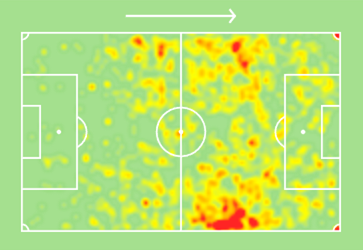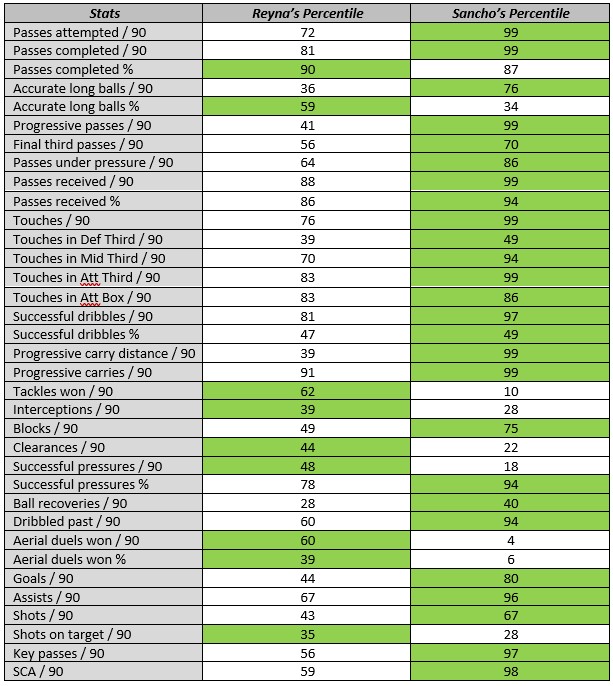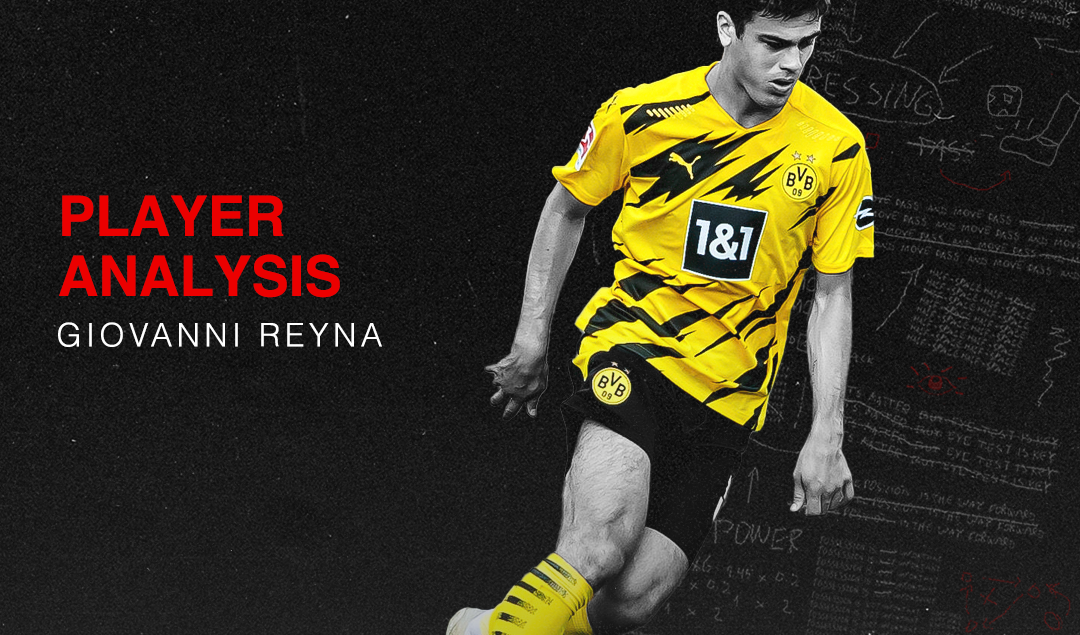Giovanni Reyna: Borussia Dortmund’s New Jadon Sancho?
The United States Men’s National Team has had its fair share of talented players, many of whom we have seen play in Europe. Some of them have even been able to collect legendary status, such as Landon Donovan, Claudio Reyna, Clint Dempsey, Brad Friedel and Tim Howard.
One of these aforementioned players has a son playing in Europe and earning a lot of praise at Borussia Dortmund. His name: Giovanni Alejandro Reyna. Borussia Dortmund have developed their fair share of talented wingers, such as Marco Reus, Christian Pulisic and Jadon Sancho, and Reyna is no different.
In fact, the young American was under the wing of Sancho ever since he arrived in Germany, and since the Englishman left Dortmund for Manchester United in the summer of 2021, one could be left to wonder if Giovanni Reyna has what it takes to take over the reins.
What Can Be Learnt About Football From Analysing 2018/19 Borussia Dortmund
In this article, we will be looking at how Reyna has performed in the 2020/21 season for Borussia Dortmund, by analysing his style of play and comparing his Bundesliga statistical and percentile numbers with Jadon Sancho.
Giovanni Reyna’s Background
Born in 2002 in Sunderland to English and American parents, Reyna grew up in New York City with his three other siblings.
His parents are former professional footballers, with his mother (Danielle Egan) being a former member of the US Women’s National Team and his father (Claudio Reyna) being a former Rangers, Manchester City and Sunderland player, along with being a former member of the US Men’s National Team.
Reyna took an interest in football from the age of 5 and, by 2015, the time was right for him to join the academy of his hometown club, New York City FC.
Despite his father being the sporting director of NYCFC, the young player’s fast rise through the ranks was down to his own talent and based on merit. His outstanding performances at youth level caught the interest of Borussia Dortmund, so much so that he joined the German club’s academy in 2019.
Brenden Aaronson: Why Are Leeds So Keen on the Salzburg Youngster?
He started the 2019/20 season with the U19s and within a matter of months – January 2020 – he joined the First Team and made his Bundesliga debut. At 17 years and 66 days old, Reyna became the youngest American ever to appear in the Bundesliga, a record previously held by Christian Pulisic.
He even recorded his first professional goal in the 3–2 loss against Werder Bremen, in the DFB-Pokal Round of 16. Just 15 days later, he became the youngest American to play and record an assist in the UEFA Champions League, assisting the match-winning goal in BVB’s 2-1 win against PSG in the first leg of the Round of 16.
In November 2020, Reyna signed a new four-and-a-half-year contract, thus extending his stay at Dortmund until at least 2025. He currently wears the number 7 shirt for the BVB, previously held by former Borussia Dortmund and current Manchester United player Jadon Sancho.
Style of Play
While an analysis of Giovanni Reyna’s 2019/20 season was already made, this analysis will focus on how he has fared since then.
Tactically speaking, the American is deployed across the attacking midfield area of the pitch, whether it is at left-wing, central attacking midfield or right-wing. Besides that, you can see from his heatmap a desire to dominate the wings.

[SofaScore’s Giovanni Reyna Season Heatmap from the 2020/21 Bundesliga season]
Reyna appears to be quite a unique player and it is difficult to assign a standard playing style from the American, and few have been able to find a comparable player to the now 19-year-old. Therefore, we will look at his key attributes in the hopes that it will help us figure out the kind of player he is.
One of the key attributes of Reyna is his technical skillset, which derives from having amazing dribbling skills, passing skills, and spatial awareness. Starting with the dribbling, he often uses it by either dropping into midfield or moving up into more forward areas.
By passing through various opposition players, he forces the defenders attempting to close him down to choose between allowing him to create numerical superiority in the zone he penetrates or tactically fouling him so that he doesn’t move further up the pitch.
As for his passing, Reyna is especially strong in open-play and set-piece situations, especially corners. He excels in open-play area by starting in deeper zones and moving into midfield to create numerical superiority, before contributing to moving the ball quickly from one side to the other.
He also enjoys moving in the middle third, where he sets up the overlapping players in the wide spaces, which in turn allows them to make incisive crosses.
Finally, in the final third, he provides through balls into the box to the striker, as Erling Håland himself enjoys making runs in behind the defence. He can be very effective at each level of the pitch.
His desire to play high up the pitch allows him to use his vision of the game to find his teammates in dangerous positions.
He will also use that same vision for spatial awareness, meaning he will look for pockets of space inside the opposition’s half, whether he is drifting and/or dropping into areas outside the reach of the opposition’s defence, or attacking the space between the defence.
Reyna has a body mass index (or BMI) of 21.2, which stems from his height of 1.83m and weight of 71kg.
This shows that not only is he well built, but he also has the physical attributes to handle physical duels, both on the ground and in the air. Add on top of that his ability to be fast, no doubt he has the potential to cause a lot of trouble for the opposition.
As a player in the attacking midfield area of the pitch, there is no doubt that Reyna’s shooting will be highlighted.
Whenever he does take a shot on goal, he is very comfortable in using his right foot, especially when taking on challenging shots, but he will generally use his left foot when dealing with simpler shots. This makes him capable to be dangerous from all sides of the pitch.
From this style of play analysis, it is simple to understand why many may struggle to pinpoint a clear playing style. However, with all this information, one could assume that Giovanni Reyna has all the skillsets to become a complete midfielder.
Statistical Analysis
Initially, I planned to analyse Giovanni Reyna’s 2020/21 season and compare it with his 2021/22 season, before the Bundesliga winter break.
However, the American youngster has only played in three out of 20 Bundesliga matches in 2021/22 (in all of which he started), because he has been injured since the El Salvador v USA CONCACAF World Cup Qualification match, which was played on the 3rd of September 2021.
Because statistics for a player who hasn’t played more than 10 league matches can be highly biased, I decided instead to use Reyna’s 2020/21 statistics, and see how they compare to Borussia Dortmund’s best-performing winger that season: Jadon Sancho.
In order to properly analyse Giovanni Reyna, we will look into the passing, possession, defensive contributions, and chance creation statistics of the 2020/21 Bundesliga season. We will then compare these statistics with Jadon Sancho in the same season and interpret these results.

[All statistics used from FBref and SofaScore from the 2020/21 Bundesliga season]
Note that the statistics shaded in green show that one player is performing better than the other on a specific statistic. Also, at the end of the 2020/21 season, Giovanni Reyna was 18 years old and Jadon Sancho was 21 years old.
The first thing we notice is that Reyna has 86 fewer game-time minutes compared to Sancho, with Reyna having started in 23/32 games he played in, compared to Jadon’s 24/26 started games he played in.
The total amount of Bundesliga matches in a season is 34, and for the Englishman, his absence was mainly in March and April, due to injury.
In terms of passing, Sancho is ahead of Reyna in most statistics. The Englishman has attempted 20.21 more passes per 90, and completed 15.65 more passes per 90 (with a lower percentage in passes completed of 0.6%).
Furthermore, he has completed 1.25 more accurate long balls per 90 (with a lower percentage in accurate long balls of 5.0%), created 3.82 more progressive passes per 90, created 0.34 more final third passes per 90, and created 1.17 more passes under pressure per 90 than the American.
Despite the percentage numbers being close or favouring Reyna, there is no doubt that one could expect a lot more from him, especially for someone well known for his passing, vision and involvement in open-play situations.
However, the number of touches and the frequency at which he receives the ball could also have an impact on said results.
In terms of possession, Sancho is ahead of Reyna in all the dribbling and ball-carrying statistics.
The Englishman has received 16.70 more passes per 90 (with a higher percentage in passes received of 2.3%) and touched the ball 20.01 more times per 90.
Sancho has completed 1.74 more successful dribbles per 90 (with a higher percentage in successful dribbles of 0.1%), carried the ball 55.37 more progressive distance per 90, and created 2.52 more progressive carries per 90 than the American.
As shown here, Sancho is being targeted to receive the ball a lot more, which explains the higher numbers in both passing and possession statistics.
This means that the Englishman was more of a focal point for Borussia Dortmund compared to the American, something that Reyna will see change naturally with more time spent with the team on the pitch.
As for defensive action, this is where we see Reyna performing better. The American has won 0.57 more tackles per 90 (with a higher percentage in tackles won of 8.6%), intercepted the ball 0.07 more times per 90, blocked 0.34 fewer times per 90, cleared the ball 0.15 more times per 90, and completed 1.17 more successful pressures per 90 (with a lower percentage in successful pressures of 4.6%).
Reyna has also recovered the ball 0.77 fewer times per 90, been dribbled past 0.52 fewer times per 90, won 0.83 more ariel duels per 90 (with a higher percentage in aerial duels won of 13.4%), and won 0.92 more total duels per 90 (with a lower percentage in aerial duels won of 6.0%) than the Englishman.
With Sancho having almost a similar height and weight, it’s surprising to see the American be more dominant in the air and defensively, but that could be simply down to the fact that the Englishman prefers the ball to feet and is not as much a fan of defending.
That being said, Reyna needs to improve his blocks and ball recoveries if he is to be more effective in Dortmund’s pressing.
Finally, in terms of chance creation, Sancho is comfortably ahead of Reyna. The Englishman has scored 0.17 more goals per 90, created 0.25 more assists per 90, shot 0.50 more times per 90, shot on target 0.10 more times per 90, completed 1.37 more key passes per 90, and completed 2.32 more shot-creating actions per 90 than the American.
With Sancho having eight goals and 11 assists compared to Reyna’s four and five, at first glance one could assume that the American’s chance creation is simply not good enough.
However, since his touches are 17.38 times lower in the attacking third and 0.34 times lower in the attacking penalty box, those chance creation statistics could improve if he had more touches in that area of the pitch.
No doubt when looking at these statistics, we can see how influential Jadon Sancho was for Borussia Dortmund. That being said, with Giovanni Reyna being around three years younger than his counterpart and having much less game-time experience, he still has an opportunity to reach the heights of Sancho’s figures.
Now while I could have decided to stop there and go straight to the conclusion, it would be a good idea to use the same statistics of Giovanni Reyna’s 2020/21 Bundesliga above, but instead, we will compare them with the percentile statistics and the average numbers of each statistic related to all other Bundesliga wingers and attacking midfielders from the 2020/21 season.
This is important because not only will it help us understand how Reyna faired against those players, but also what he needs to improve on to become one of the best attacking midfielders and wingers in the Bundesliga.

[All statistics were used from the FBref Player Scouting Report section, in relation to the 2020/21 Bundesliga season]
Note that some statistics previously mentioned in the Sancho comparison will not be included, as they are not mentioned in the Player Scouting Report made by FBref. Also, the statistics shaded in lime green show where Reyna is performing better than the median.
At first glance, the percentiles show a very volatile range of statistical figures compared to the other attacking midfielders and wingers.
With the accurate long balls per 90 placing him in the 36th percentile and progressive passes per 90 placing him in the 41st percentile, we initially expected it to be because he doesn’t receive the ball and doesn’t touch the ball as much as Sancho.
But when compared to other Bundesliga midfielders, we observe the same difference.
His passes received per 90 put him in the 88th percentile and his touches per 90 put him in the 76th percentile, with touches in the defending third putting him in the 39th percentile and in the middle third putting him in the 70th percentile.
From this, it seems that Reyna underscoring in accurate long balls and progressive passes is probably more linked to the fact that he likes to play with his ball to feet rather than passing the ball around.
In terms of possession, despite having the successful dribbles per 90 in the 81st percentile, the successful dribbles percentage is in the 47th percentile.
While this percentile is close to the median, an improvement in that area could allow him to showcase even more his technical skillset.
Furthermore, his progressive carrying distance per 90 puts him in the 39th percentile, so it is something to work on over time but could be down to Dortmund’s style of play.
As for defensive actions, some of the percentiles are not that far off the median: blocks per 90 (49th), clearances per 90 (44th) and successful pressures per 90 (48th).
What is concerning is how low those percentile figures are for interceptions (39th), ball recoveries (28th) and aerial duels won (39th) per 90, especially when the aerial duels won per 90 are in the 60th percentile. It seems to further reinforce the fact that more is expected from him in that area.
Despite doing well in some areas of chance creation, the goals (44th), shots (43rd) and shots on target (35th) per 90 are below the median.
Even though his touches in the attacking third and attacking box put him in the 83rd percentile, this could be because he doesn’t have too much confidence in his shooting ability and prefers to let the other attacking players, like Sancho and Håland, take more shots on goal.
For those interested in finding out how Giovanni Reyna’s Percentile compares to Jadon Sancho’s Percentile, you will be able to find that information below.

[All statistics were used from the FBref Player Scouting Report section, in relation to the 2020/21 Bundesliga season]
As mentioned before, note that the statistics shaded in green show that one player is performing better than the other on a specific statistic.
No doubt that Sancho is not known for his defensive statistics, but apart from those very rarely will you see him break below the 70th percentile.
In fact, only in four out of 25 statistics has this happened: accurate long balls percentage (34th), successful dribbles percentage (49th), shots per 90 (67th) and shot on target per 90 (28th).
Compare that to Reyna’s quite volatile percentile numbers, and it is not difficult to understand why the Englishman has been so beneficial to Borussia Dortmund.
Conclusion
To summarise, Giovanni Reyna’s 2020/21 season has shown that he has a significant amount of potential. The now 19-year-old American has the attributes to become a complete midfielder for the BVB, given his technical skillset and physical attributes.
What he needs to do now is showcase more of those attributes. For example, he needs to be more effective in the use of his body for defensive actions, aerial duels and ball retention. This in turn would allow him to be more useful in a high pressing tactical style of play, especially one where the team presses all over the pitch.
It’s still too soon to say if Reyna can take over the reins from Jadon Sancho, and the injury that he sustained in September will surely not have helped his development at the BVB.
However, having an experienced manager in Marco Rose could help him to find his football identity, and given how the new manager has been able to unlock Julian Brandt, Marco Reus and Jude Bellingham even more, this could give Reyna more confidence to improve as a footballer.
Borussia Dortmund has a long history of investing in young talent and giving them a chance to become First Team regulars.
While some have or possibly will treat the German side as a steppingstone to join Europe’s elite clubs, I expect Giovanni Reyna to stay in the black and yellow for the foreseeable future where he can further develop his skills that take him to the next level.
By: Alexander Huyberechts / @cfcalex98
Featured Image: @GabFoligno / DeFodi Images
